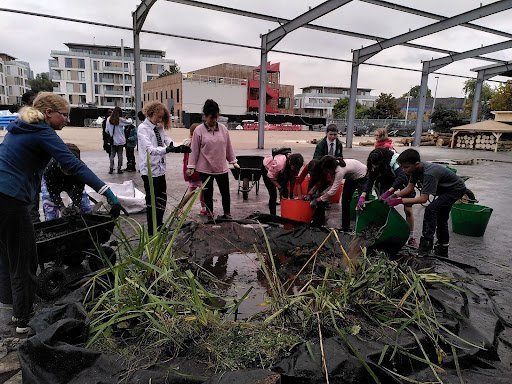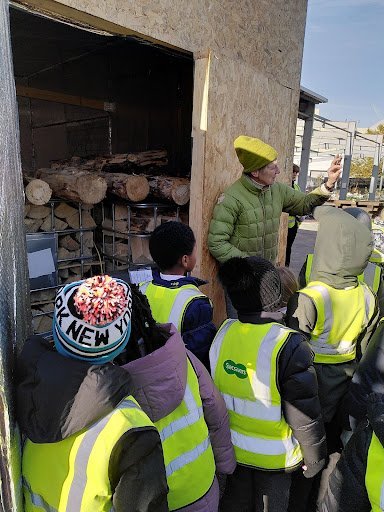Months in the growing garden and rising classroom walls
The build of the new Paper Garden is underway. In the summer Keltbray stripped the metal walls of the giant old shed, leaving a frame for us to grow a new garden in.
The wood from Epping Forest for the cordwood classroom arrived. Then the pond appeared in the garden, transported bucket by bucket from the old wildlife area, preserving the water's equilibrium, saving the mayfly and dragonfly larvae for another year of growth. They now occupy their new home, built for a second time by the Generators. It’s fitting, that the water that connects us all was the first footprint of the garden on the new concrete.
This was my first time moving a garden, and when I told people we were in the process of moving the Paper Garden they often responded, “That’s crazy! How do you move a garden?” Fortunately, woven into the Paper Garden’s story is the ground's ability to move, we always knew the time would come. And so when we needed to start digging the fabric of the garden's body into the 50 large tonne bags with garden visitors it felt harmonious with the journey.
The woodchip and the native hedge was transported, the fox gloves were transplanted, stag beetle larvae travelled across the old Daily Mail Printworks. Galldris construction company kindly hoisted the living matter onto lorries to recollect the hard work of 4 years to the new home.
The 98 Beuys Oak trees arrived. Wasp galls and the mycelium arrived alongside them. New stories travelled to the minds of small children and adult volunteers, tales of concrete that sits on the back of the giant bird, the children who changed the city, and the moon who talked to the sun and the waves.
Then, as we sped through autumn, winter arrived. As the foxes made nests in the warm insulation for our classroom build it dawned on us that the build was planned for the summer, not the cold, ever more unpredictable winter.
Yes Make, who are building the cordwood walls with the community, told me the news as we stood around a beautiful test panel of the cordwood. The lime that was to hold up the cordwood walls of our classroom will not set in the cold, and we would be left with porridge if we plough ahead. We had some possible options, pause the build of the walls, or add concrete to the mix and hope that that sets - a chance to jump ahead? To beat the cold? It’s true, the new ways of concrete seep sneakily and easily into all our consciousness.
Delays in the build means longer to wait without office space, a classroom, a community kitchen, and potentially higher costs. How do we face these challenges without heading into battle with the cold?
I paused, and shook my head. I didn't expect to react so quickly but the limestone had a voice through me.
We cannot fight the winter, we must slow down. As we stretch the limits of reclaimed material usage and cordwood construction, we are bound to hit obstacles and being a gardener, I am accustomed to the weather being one.
As nature teaches us, with slowing down, arises new possibilities. We have built 8 new community growing beds on our wood work Saturdays - we hadn’t planned to have them ready until spring 2022. More people than previously planned will be able to learn new skills, experience working with new materials, and come together in the new Paper Garden, over a 2022 springtime build of the cordwood walls.
We are extremely grateful for the friendship of Wates construction, British Land, Aecom, Jan Kattein Architects, Waterman Group, Yes Make, Network Rail, Nordan, Sweco and all of the contractors: O’Neill and Brennan, Trident Electrical Services Ltd, Getjar Ltd, Diva Metalwork, Bridgegap, Sunbelt Rentals Limited and Ecoright, who are supporting and enabling the building of the cordwood classroom. Together we are tackling the challenges that face city construction, searching for new but old ways of building in the city, with nature always close in mind and soul. We are grateful for the continued support of the local visitors, who’s many hands make joyful work in the growing of plants, and community for a just world.








The barge art session hosted by Sarah Pimenta and Pia Jones was reviving.